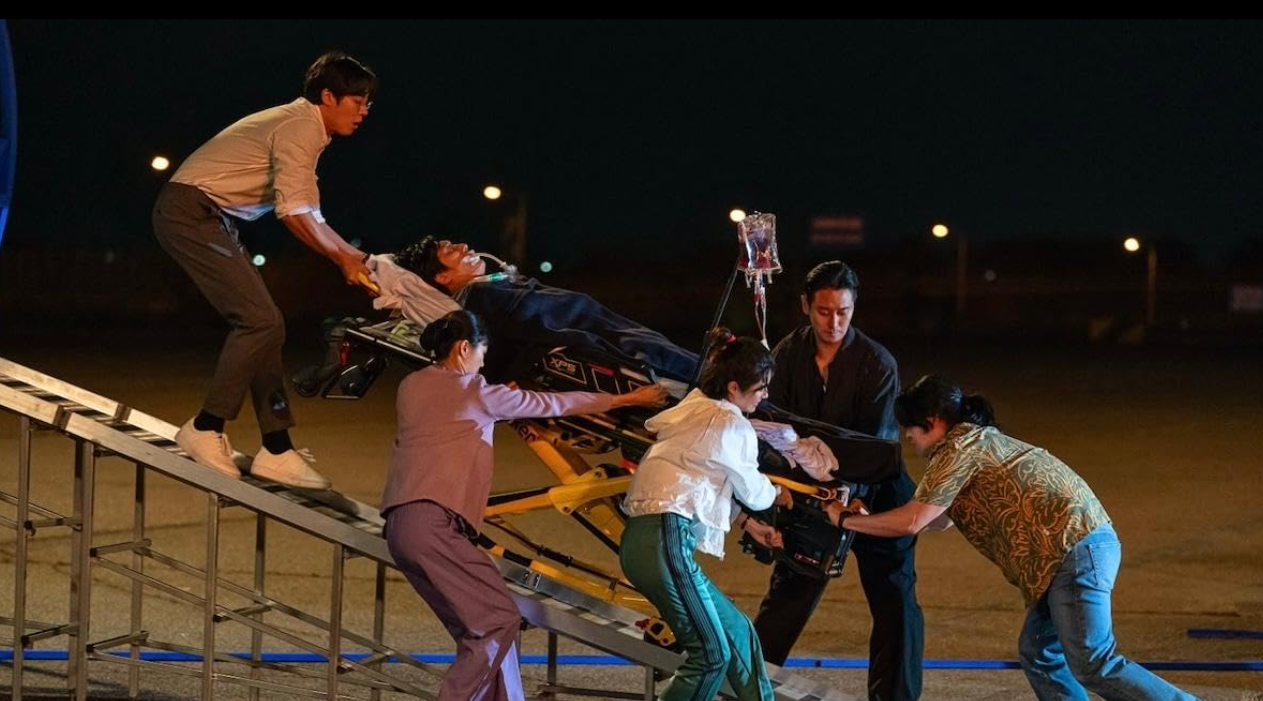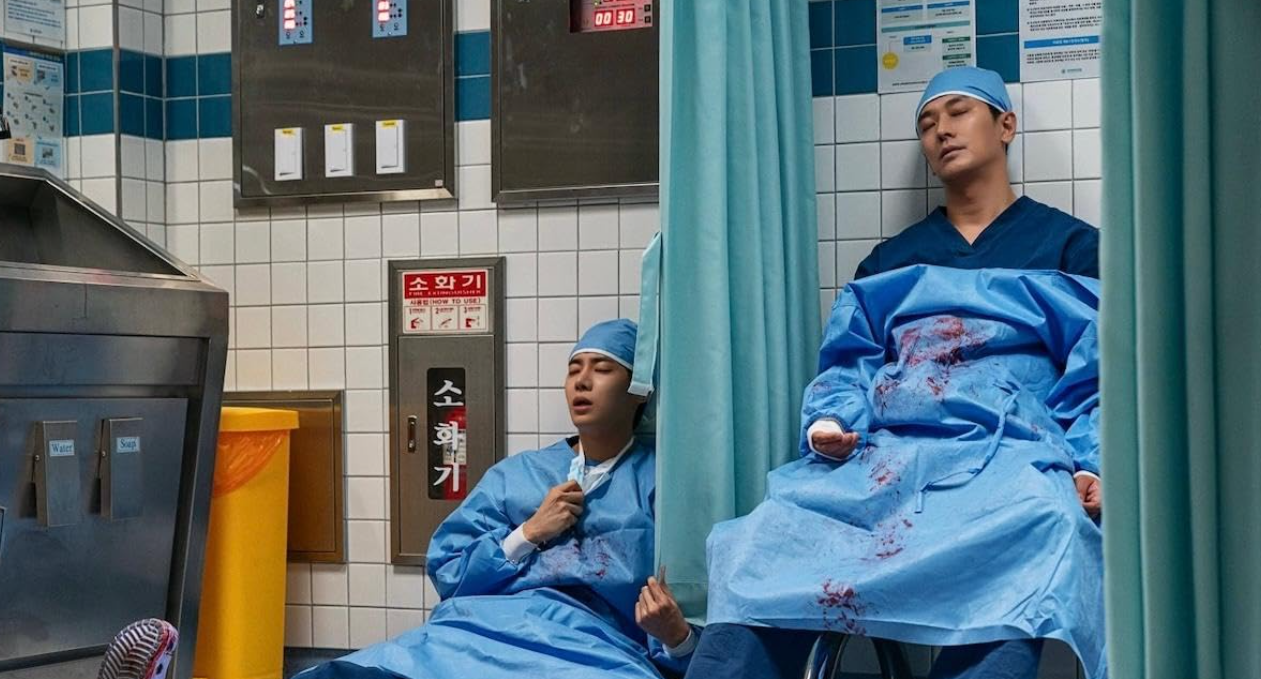The Trauma Code: Heroes on Call (2025) is a South Korean medical drama-comedy series that delivers high-octane hospital action with a hearty dose of humor. As Netflix’s first original Korean medical drama, this 8-episode show centers on themes of heroism, teamwork, and fighting the odds in emergency medicine.
It follows a battle-hardened trauma surgeon thrust into a struggling hospital unit, blending intense life-and-death moments with witty banter and uplifting camaraderie. Released in early 2025, The Trauma Code quickly became an instant hit, even breaking into Netflix’s Top 10 most-watched shows in the U.S. upon release.
With its mix of adrenaline-fueled rescues and heartfelt humor, this K-drama offers a fresh take on the medical genre that’s perfect for fans of fast-paced series like Grey’s Anatomy.
This review will walk you through all aspects of The Trauma Code: Heroes on Call – from its spoiler-free story synopsis and production background to an in-depth analysis of its plot, characters, themes, and visuals. You’ll learn about the director, writers, and star-studded cast, as well as how the show reflects Korean cultural elements and compares to similar dramas.
We’ll also discuss strengths and weaknesses, highlight some memorable scenes (without spoilers), and look at how audiences and critics have received this series – including ratings and awards. By the end, you’ll have a clear picture of what makes The Trauma Code stand out and whether it’s the kind of drama you’ll want to binge or put on your watchlist.

Jump to:
✨ Synopsis (Spoiler-Free)
In The Trauma Code: Heroes on Call, renowned trauma surgeon Baek Kang-hyuk (played by Ju Ji-hoon) arrives at Hankuk National University Hospital with a mission: to turn its failing trauma unit into a top-tier center.
Kang-hyuk is no ordinary doctor – he’s a brilliant surgeon forged in war zones around the world, so he brings unconventional methods and a blunt “bull in a china shop” personality. On his first day, he dives headfirst into crisis, performing impromptu surgeries during disasters (even mid-air in a helicopter during one daring rescue) and shocking the more traditional hospital staff.
His unorthodox, maverick style initially ruffles feathers – especially with by-the-book colleagues like Professor Han Yu-rim (Yoon Kyung-ho) – but Kang-hyuk’s results speak for themselves.
He soon takes a ragtag team under his wing: idealistic junior doctor Yang Jae-won (Choo Young-woo), resourceful head nurse Cheon Jang-mi (Ha Young), and quirky anesthesiology resident Park Gyeong-won (Jung Jae-kwang).
Together, they tackle a series of dramatic emergency cases, from multi-car pileups to major disaster incidents, pushing the limits of their skills and teamwork. As the central conflict, Kang-hyuk must prove that saving lives comes before hospital politics and profit – all while teaching his team to become true “heroes on call.”
The tone shifts smoothly between tense, high-stakes medical emergencies and lighthearted comedic moments as the team bonds. Throughout the journey, the show keeps viewers on edge with constant challenges, but stays spoiler-free here: just know that every episode brings new obstacles that test the team’s resolve and heart, without ever losing its fun streak.
🎥 Production Details
Director
The Trauma Code is directed by Lee Do-yoon, marking his television debut. Lee previously helmed the 2014 crime film Good Friends (Confession), which, coincidentally, also starred Ju Ji-hoon, making this drama a reunion of actor and director after a decade. His direction brings a cinematic flair to the series’ action scenes, likely drawing on his film background.
Writer
The screenplay is written by Choi Tae-kang, known for crafting twisty thrillers like Adamas (2022). Here, Choi adapts the story from the hit web novel and webtoon “Trauma Center: Golden Hour,” originally written by real-life doctor Lee Nak-joon.
This source material gives the drama its authentic medical details and webcomic-style energy. The show’s genre is a blend of medical drama and comedy, so expect both intense ER moments and laugh-out-loud scenarios.
Cast & Network
The cast is led by Ju Ji-hoon as Dr. Baek Kang-hyuk. Ju Ji-hoon is a top-tier actor known for his roles in Princess Hours (2006) and Netflix’s own zombie hit Kingdom. Here, he channels all his charisma into playing the genius “combat surgeon” with a heart of gold.
Choo Young-woo co-stars as Dr. Yang Jae-won, Kang-hyuk’s earnest protégé – a breakout role for Choo, who previously appeared in youth dramas like School 2021 (2021)and the romance Once Upon a Small Town.
Ha Young (a.k.a. Shin Ha-young) plays Nurse Cheon Jang-mi; fans might recognize her from supporting roles in Now, We Are Breaking Up (2021) and a memorable cameo in Extraordinary Attorney Woo. Rounding out the main team, Jung Jae-kwang (from The Fiery Priest and Nevertheless) is the warm-hearted resident Dr. Park, and Yoon Kyung-ho portrays Professor Han Yu-rim. Yoon is a veteran character actor seen in hits like Itaewon Class and Goblin.
The drama also features familiar faces like Kim Eui-sung (of Train to Busan fame) as the hospital director and Kim Won-hae (known for Strong Woman Do Bong-soon and SNL Korea) as a scheming hospital administrator.
Network & Episodes
The Trauma Code: Heroes on Call was produced by Studio N (noted for webtoon adaptations) and released globally on Netflix as an original series. It premiered on January 24, 2025, with all 8 episodes dropping for binge-watching (each episode runs ~47–55 minutes). Notably, only having 8 episodes is shorter than the typical K-drama, but this tighter format results in a fast-paced, no-filler narrative.
The show’s quick release and Netflix backing allowed it to reach international audiences immediately – and it clearly succeeded, as we’ll see in the reception section.
Behind the scenes, the production put effort into authenticity: the original web novel’s author (a real doctor) was involved, and actress Ha Young even underwent special training to portray a nurse realistically. Overall, the production quality is high, with Netflix’s budget evident in the impressive disaster set pieces and slick cinematography.

🔍 Detailed Analysis
Plot Development (Pacing, Originality, Coherence)
The Trauma Code wastes no time plunging viewers into the thick of emergency medicine. The pacing is brisk and exhilarating – with only 8 episodes, there’s virtually no filler or dull moment (many fans binged it straight through without pausing).
Each episode presents at least one major medical crisis or action set-piece, keeping you on the edge of your seat. From the pilot episode’s chaotic introduction of “Doctor Maniac” Kang-hyuk diving into multiple accidents, to later episodes featuring a high-risk helicopter surgery and even a bridge collapse rescue, the plot keeps upping the ante.
This relentless momentum makes the show incredibly bingeable — “the curveballs keep coming and there is always something to keep viewers clicking on the next episode,” as one reviewer noted. Despite the rapid pace, the storyline stays coherent and easy to follow. The writers smartly focus on the central arc of transforming the trauma center and the team’s growth, rather than overloading us with subplots.
There are some familiar medical drama tropes (hospital politics, a bureaucratic villain, a maverick surgeon with a tragic past), but the show’s original twist is Baek Kang-hyuk’s ex-mercenary background and over-the-top heroics. One minute, he’s calmly saving a patient’s life, the next, he’s riding a motorcycle or literally piloting a helicopter to reach those in need. This blend of action-movie spectacle with medical drama is refreshingly original, even if it occasionally stretches believability.
The tone can shift from serious to silly in a heartbeat – a risky move that The Trauma Code mostly pulls off. Viewers do need to suspend disbelief (some situations border on comic-book levels of exaggeration), but that’s part of the charm.
Overall, the plot development is tight, inventive, and consistently entertaining, offering a satisfying balance of predictability (you know our heroes will attempt the impossible every time) and surprise (how they’ll pull it off is often unexpected). If you enjoy a show that moves at breakneck speed and isn’t afraid to be a little outrageous, this one’s coherence amid the chaos will impress you.
Characterization (Performances & Growth)
One of the drama’s strongest assets is its memorable characters and the performances behind them. Ju Ji-hoon leads the pack as Dr. Baek Kang-hyuk, and he is simply magnetic. Ju brings a perfect mix of intensity, comedic timing, and depth to the role of the genius doctor who’s equal parts maverick hero and lovable troublemaker.
Critics have praised his turn – the South China Morning Post even said Ju Ji-hoon has “seldom been better” and that Kang-hyuk is a “picture-perfect” role that plays to the actor’s strengths. Kang-hyuk’s character might have been a cartoonish, arrogant caricature in lesser hands, but Ju imbues him with a charm and sincerity that make you root for him, crazy antics and all.
Over the series, we see Kang-hyuk evolve from a lone wolf “combat surgeon” into a true mentor and team player, especially as he bonds with his young colleague Jae-won.
Speaking of Yang Jae-won, newcomer Choo Young-woo delivers a standout performance as the idealistic junior doctor. Jae-won starts off timid and a bit out of his depth – he’s a proctology fellow nicknamed “Anus” (yes, really) who suddenly finds himself assisting on trauma surgeries.
Under Kang-hyuk’s tough-love guidance, Jae-won grows in confidence and skill, transforming into a competent trauma surgeon in his own right. Choo Young-woo’s portrayal feels genuine and endearing; no wonder he snagged a “Best New Actor” award for this role.
The mentor-mentee chemistry between Ju Ji-hoon and Choo Young-woo is a heartwarming backbone of the show – their banter provides many comedic beats, and their mutual respect yields some emotional payoffs as well.
The supporting characters each bring something special. Cheon Jang-mi, the no-nonsense nurse played by Ha Young, is both the emotional glue and comic relief of the team. She’s often seen keeping the doctors in line with her seasoned nurse wisdom (and scolding them with witty one-liners), yet she’s also in the thick of action during critical moments.
Ha Young’s performance is charismatic, and viewers were impressed to learn she studied real nurses’ habits to add authenticity.
Han Yu-rim (Yoon Kyung-ho) starts as an antagonistic figure – the arrogant surgery chief who bristles at Kang-hyuk’s disruption – but even he gets layers. Yoon, a veteran of many dramas, makes Han more than a one-note villain; you see hints of pride and concern under his bluster. By the end, even Han’s character experiences a bit of growth (albeit begrudgingly acknowledging Kang-hyuk’s impact).
Park Gyeong-won (Jung Jae-kwang), the anesthesiology resident, provides a quieter but important presence – he’s the loyal friend to Jae-won and proves clutch in several emergencies. Jung brings a warm, everyman quality that balances the louder personalities.
Beyond the main trauma team, there are scene-stealing veterans: Kim Eui-sung as the hospital director Choi is deliciously infuriating, embodying bureaucracy and greed that our heroes must battle. Kim Won-hae, as the hospital’s planning chief, adds both humor and tension.
His comedic pedigree (from SNL Korea) shines in snarky dialogues, yet he can turn menacing when plotting against the trauma unit. These well-cast supporting actors give the world of The Trauma Code a lived-in feel. Notably, the drama is free of any romantic subplot, which is rare for K-dramas. This allows it to focus purely on professional and platonic relationships – a choice many fans appreciated, as it highlights teamwork and friendship over romance.
The camaraderie among the trauma team feels genuine; you believe these people become like family through their trials. By the finale, each character has grown: Kang-hyuk learns humility and trust, Jae-won gains courage, Jang-mi reinforces her pivotal role, and even the skeptics come around.
The cast’s strong performances ensure that the character development hits home. In short, The Trauma Code gives us a colorful ensemble of heroes you can cheer for, portrayed by actors at the top of their game.
Themes and Messages
Amid the adrenaline and humor, The Trauma Code: Heroes on Call carries clear themes and messages. At its core, this is a story about doing what’s right in the face of injustice. Kang-hyuk and his team frequently clash with hospital administrators who care more about budgets and reputations than saving patients.
This highlights a real-world issue: trauma centers often operate at financial loss for the greater good. The show doesn’t shy away from pointing out that saving lives isn’t profitable, but it’s necessary – a commentary on Korean healthcare systems and beyond.
In interviews, Ju Ji-hoon noted he never saw this as “just a medical drama,” but rather “it’s about injustice – something that exists in every profession… in this drama, our team gets to do something about them”, which makes it satisfying.
Indeed, each episode features our heroes confronting some form of injustice, whether it’s an underfunded trauma department, a cover-up by higher-ups, or simply the unfair twists of fate that befall their patients. The message is consistent: skilled and compassionate people working together can overcome systemic obstacles and save lives, which is deeply inspiring.
Another prominent theme is mentorship and growth. Kang-hyuk’s mentorship of Jae-won underscores the importance of experienced professionals guiding the next generation. The series celebrates the passing of knowledge and values – Kang-hyuk instills in Jae-won not just surgical skills but courage and empathy.
This ties into a broader theme of teamwork and trust. Initially, the trauma unit members are disparate and doubtful, but through crisis after crisis, they form an unbreakable trust. The drama essentially says: in the most dire situations, you need to lean on your colleagues – no hero can do it alone, not even a “Doctor Maniac.”
The slogan could well be “all hands on deck,” as time and again we see nurses, fellows, pilots, and even government officials collaborating to avert disaster. The camaraderie and unity are a feel-good takeaway that resonates with viewers who enjoy stories of people coming together for a noble cause.
The show also touches on resilience and hope. Many episodes force characters to confront possible failure or past trauma (for example, hints of Kang-hyuk’s own painful past from his combat medic days). Yet, the tone remains uplifting; even when things look bleak, someone finds a creative solution or inspires others to push on. This aligns with the drama’s webtoon origins – there’s an almost comic-book heroism in how Kang-hyuk & co. never give up.
The tagline on Netflix labels the show “witty” and “inspiring” and about “overcoming the odds,” and the content indeed delivers that. It’s as much about saving spirits as saving lives. When a character finds the strength to stand up to bureaucracy or a rookie conquers his self-doubt to perform a critical procedure, those moments carry an encouraging message: be bold, do good, and you can change the world around you.
Lastly, being a Korean drama, there are subtle themes of duty and honor in one’s profession (a very Confucian underpinning). Kang-hyuk’s personal creed is that a doctor’s duty is absolute, even if it means bending rules – he often says some variation of “patients come first.” This idealism contrasts with others’ careerism, thereby reinforcing the show’s ethical standpoint.
In summary, The Trauma Code uses its thrilling storyline to highlight serious themes: justice versus corruption, teamwork, mentorship, and the unwavering commitment of medical “heroes” to their calling. It wraps these messages in an entertaining package, leaving viewers not just excited, but also inspired and thoughtful about the real heroes in hospitals every day.
Cinematography and Soundtrack
Cinematography: Visually, The Trauma Code is dynamic and polished. The camera work effectively captures the frantic energy of emergency scenes – expect shaky cams and rapid cuts during surgeries and disaster rescues that put you right in the chaos.
In one standout sequence, as the team performs emergency surgery in a helicopter, the camera pans claustrophobically tight on the actors’ faces and hands, conveying the tension and turbulence of the moment.
Conversely, during lighter scenes (like the team grabbing late-night snacks or teasing each other in the break room), the show uses steadier, wider shots, giving us a breather and highlighting the character interactions.
The action scenes are almost movie-like in scope: for the episode with a bridge collapse, the production goes all out – aerial shots of the disaster site, practical effects with flipped ambulances, and well-integrated CGI for wider destruction. It’s impressive for a drama, and even if you spot some CGI seams here and there, it doesn’t detract from the excitement (as one fan noted, the occasional obvious CGI doesn’t spoil how good the drama is).
The cinematography also emphasizes Kang-hyuk’s “hero moments” with flair – you’ll see cool slow-motion shots of him striding into the ER or dramatic angles when he’s about to attempt an unorthodox procedure, underlining his almost superhero persona. Yet, it’s not all flash; there are tender visual moments too, like a quiet scene on the hospital rooftop at sunrise, giving emotional beats the space to land.
Overall, the visual storytelling is engaging and varied, balancing intense close-ups for drama with expansive shots for scale. The color palette tends to be realistic (sterile hospital whites, scrub blues), but during comedic bits, you might notice brighter lighting and warmer tones, subtly cueing the mood. This thoughtful cinematography helps the show juggle its tonal shifts smoothly.
Soundtrack: The soundtrack of The Trauma Code complements its hybrid tone. During critical operations or rescue scenes, expect a pulse-pounding score – fast-paced orchestral strings and percussion that raise your heart rate as if you’re in the ER with the team. These adrenaline-fueled background tracks ramp up the suspense effectively; more than once, you might catch yourself holding your breath as the music crescendos while a patient’s vitals drop.
In contrast, the show’s comedic and heartwarming scenes feature a lighter musical touch. There are upbeat, almost whimsical background tunes that play when Kang-hyuk is bantering with colleagues or when the team celebrates a victory, reinforcing the drama’s fun side. The OST likely includes a couple of vocal tracks as well (as is K-drama tradition) – typically emotional ballads or inspiring anthems that might play over montage sequences or end-credits.
One notable song, for instance, swells during a montage of the trauma team saving patients across different emergencies, its lyrics about “holding on” and “heroes” matching the theme (fans online have been sharing an OST track titled “Breathe Again” which fits this vibe).
The sound design also deserves credit: the beeping of monitors, the roar of helicopter blades, the crunch of collapsing structures – these audio details are sharp and immersive. In quiet moments, the show isn’t afraid of silence either, letting a touching conversation between characters land softly with minimal music.
When the music does come in for emotional climaxes, it’s appropriately stirring (prepare for some feels when a particular piano melody plays during a mentor-mentee heart-to-heart).
All in all, the soundtrack may not have a breakout K-pop song, but it perfectly serves the narrative, intensifying thrills and tugging heartstrings right on cue. By the end, you might find the main instrumental theme (often played when the “heroes on call” assemble for action) stuck in your head, giving you a little jolt of inspiration.

🌍 Cultural Context
The Trauma Code is not only entertaining but also offers a peek into Korean societal and cultural elements, especially related to healthcare. Firstly, the drama sheds light on the Korean medical system, particularly the challenges of trauma care.
In South Korea, there has been real public discourse about the shortage of properly funded trauma centers and the struggles doctors face under immense pressure.
This show directly mirrors that reality; the hospital in the drama hesitates to support the trauma team because saving critical patients is costly and often unprofitable. It’s a critique that Korean viewers would recognize: the tension between a hospital’s business interests and the urgent need for better emergency care.
When the series depicts government officials like the Health Minister character (played by Kim Sun-young) stepping in to champion the trauma center, it echoes how, in real life, Korean government agencies have had to push for improvements in trauma services. International viewers get a sense of how serious a topic this is in Korea – essentially, the show uses its story to comment on a social issue (hence Netflix tagging it as a “Social Issue Drama”).
Another cultural aspect is the hierarchical workplace dynamic prevalent in Korea. We see it in how younger doctors address seniors as “Professor” or “Chief” and initially defer to them. Dr. Baek Kang-hyuk’s blunt, no-formality style is considered extremely rude by Korean standards; he doesn’t use honorific speech and calls out higher-ups without hesitation.
This becomes a source of both conflict and comedy. Korean audiences would immediately pick up on how out of line (yet refreshing) Kang-hyuk is in a society where hierarchy and respect are deeply ingrained. The drama has fun with this: there’s a cultural catharsis in watching a maverick ignore strict seniority rules to do the right thing.
It subtly asks, what’s more important: saving face or saving lives? The answer is obvious, but seeing those norms challenged is gratifying in the K-drama context.
Meanwhile, characters like Han Yu-rim embody the traditional senior – he expects deference and feels “stolen” when his junior Jae-won leaves his department. This too is a specifically Korean nuance, highlighting how loyalty to one’s mentor or department can cause friction when broken.
The show also incorporates little cultural slices of life. For instance, there are scenes where the team grabs a late-night meal of jjajangmyeon (black bean noodles) or soju after a tough day, a nod to the Korean work culture of team dinners (hoesik) and comfort food after work stress. We see nurses and doctors bowing to each other in hallways, even amid emergencies, reflecting ingrained politeness.
There’s also the depiction of media and public pressure: in one plotline, a patient’s case becomes a high-profile news story, and we see how Korean media can be intense and how hospitals worry about public image (very relevant in a country with a hyper-connected society).
Additionally, the drama touches on the idea of collective effort versus individual heroism, which aligns with Korea’s collectivist culture. While Kang-hyuk is a star, he constantly emphasizes team success (he often uses “we” instead of “I”).
This might be different from some Western medical shows where one brilliant doctor is the lone savior; The Trauma Code culturally leans on the concept that everyone – from the ambulance crew (even a 119 rescue helicopter pilot makes an appearance) to the government – must work together in disasters.
For international viewers, the show provides a digestible look at Korean hospital operations (like the role of a fellow vs. a resident, or the existence of a national 119 emergency rescue unit) without heavy explanation, letting these cultural elements simply play out.
It’s also interesting to note the absence of a romance subplot, which in itself reflects a bit of changing trends in K-dramas – willing to break from the formula to focus on other themes (possibly influenced by its webtoon origin and Netflix’s global audience).
In summary, The Trauma Code is distinctly Korean in setting and social commentary – from hierarchical tension to systemic critique – yet its core messages of heroism and teamwork are universal.
It gives you enough local flavor to learn something about Korea’s medical field and work culture, all while ensuring you’re wrapped up in a universally relatable story of everyday heroes fighting the good fight.
⚖️ Comparisons
Fans of the medical drama genre will find The Trauma Code: Heroes on Call both familiar and unique compared to its peers. Within Korean dramas, one obvious comparison is Dr. Romantic (Romantic Doctor, Teacher Kim) – another series about a genius maverick surgeon reforming a hospital team. The Trauma Code feels like a hyper-energized, less melodramatic cousin to Dr. Romantic.
As one review pointed out, this show takes the heroic medical antics seen in Dr. Romantic and “both pares it down and amps it up,” simplifying characters but dialing up the adrenaline to scratch viewers’ itch for heroic highs.
If you enjoyed the mentor-student dynamics and emergency cases in Dr. Romantic, but could do with more humor and a faster pace, The Trauma Code delivers exactly that. Conversely, those who prefer the romantic and teaching aspects of Dr. Romantic should note that The Trauma Code skips romance entirely to focus on action and comedy.
Another point of reference is Hospital Playlist, a beloved K-drama that also centers on a group of doctors and teamwork. However, Hospital Playlist is more of a slice-of-life, character-driven story with gentle pacing and lots of heartfelt moments (and plenty of romance and music).
The Trauma Code veers in the opposite direction – it’s more plot-driven, with high-stakes scenarios every episode, and a comedic tone reminiscent of an action-comedy film.
You could say The Trauma Code is to medical dramas what a summer blockbuster is to dramas – it’s there to pump your adrenaline and make you laugh, rather than make you cry or deeply introspect. That said, both shows share a lovely emphasis on friendship among colleagues and the idea of doctors truly caring for patients.
In terms of international comparisons, fans of Grey’s Anatomy (especially its earlier, fast-paced seasons) might appreciate The Trauma Code. It has that similar “all hands on deck” excitement of emergency medicine that Grey’s often showcases, but with far less soap-opera romance.
In fact, The Trauma Code sometimes feels closer to an ensemble action series than a soap, making it somewhat unique in the medical genre. Some viewers have likened its tone to a blend of ER (for the chaotic trauma cases) and a Marvel movie (for the larger-than-life hero moments and quips).
And since it’s based on a webtoon, it shares a kinship with other K-dramas adapted from comics, such as Sweet Home or D.P., which often have a slightly exaggerated, stylized feel. If you’ve seen Descendants of the Sun (another K-drama where a doctor deals with disaster scenarios and military settings), you’ll find a bit of that flavor here too – minus the sweeping love story, of course.
From the creators’ side, this drama was a new venture; it’s the first time director Lee Do-yoon tackled a series, and writer Choi Tae-kang usually writes thrillers, so there isn’t a direct previous show from them to compare.
However, the influence of the webtoon genre is apparent. Like many webtoon-inspired dramas, The Trauma Code has a brisk narrative, clear-cut heroes and villains, and a tendency to escalate situations in an almost comic book fashion (for example, Kang-hyuk’s near-superhuman stamina and skills could come straight from a manhwa).
This sets it apart from more realistic medical dramas such as Life (2018) or The Good Doctor (2013), which took a grounded, serious approach. In summary, The Trauma Code stands out by combining elements from various corners: it’s as thrilling as an action movie, as funny as a buddy comedy, and still rooted in the medical drama tradition of compassionate doctors.
It fills a niche – if you like your medical dramas with a side of laughs and a big serving of heroic action, there’s really not much else quite like The Trauma Code: Heroes on Call.
💭 Personal Impressions
Strengths
The Trauma Code: Heroes on Call shines brightest in how entertaining it is. The biggest strength is its fast-paced storytelling – it hooks you from episode 1 and never lets go.
There’s always a new emergency or challenge around the corner, so you’ll rarely feel bored. The show also masterfully blends genres; it’s impressive how you can be biting your nails one minute and genuinely laughing out loud the next.
The humor, especially, was a pleasant surprise – from Kang-hyuk’s cheeky one-liners to the running gags (like Jae-won’s unfortunate nickname or the team’s banter about Kang-hyuk’s “crazy” methods), the comedy never felt forced.
Another strength is the cast chemistry. You can tell the actors had a blast with these roles. The camaraderie among the trauma team comes through warmly, making you care about their success as a group.
Ju Ji-hoon’s commanding presence as the lead and Choo Young-woo’s earnestness create a delightful mentor-protégé dynamic that forms the heart of the series. Production-wise, the show’s high quality is evident – those big action scenes were very well executed for a TV series, and they give Trauma Code an almost cinematic thrill.
In short, the drama’s strengths lie in being consistently gripping, fun, and emotionally rewarding – it’s the kind of show that can make you cheer and laugh and maybe even tear up a bit, all within one hour.
Weaknesses
While the series is a joyride, it isn’t without a few minor flaws. The primary weakness some might cite is the lack of realism – The Trauma Code is not the show to watch for accurate medical procedure or a grounded hospital experience.
The lead character often pulls off implausible feats (surgery in mid-air? drifting an ambulance? using ex-mercenary combat moves in a hospital ward – you name it), which might make you roll your eyes if you prefer realism. The tone, too, might be jarring for some; it can switch from slapstick comedy to intense drama at the drop of a hat.
For most, that’s part of the fun, but if you’re not prepared, the cartoonish elements, as one critic described, can be “a bit too silly” with a “cartoonishly arrogant” here, which might be a turn-off. Another potential weakness is that, at only 8 episodes, a couple of story threads and side characters don’t get as much development as you’d hope. For example, we get hints about Kang-hyuk’s past and emotional scars, but they’re only briefly explored.
Some supporting characters (like the other hospital staff) come across as stock figures (e.g., the one-note greedy director, the jealous rival) because the show doesn’t have the luxury of time to flesh everyone out deeply. Additionally, viewers who love the romantic side of K-dramas might feel something is “missing” here – the absence of any romance means the narrative can occasionally feel straightforward or lacking an extra emotional layer that a love story might provide.
And finally, a tiny gripe: the ending, while satisfying, leaves a few questions unanswered and clearly sets up for a potential Season 2 (you might find yourself saying, “Wait, we need more!”).
These weaknesses, however, are relatively small in the grand scheme. They mostly boil down to The Trauma Code unapologetically being an action-packed comic-book style drama – if you embrace that, the weaknesses won’t bother you much at all.
Memorable Moments
This drama delivered some unforgettable scenes that still stick in the mind. Without giving away spoilers, one can highlight a few generally: The helicopter surgery scene in episode 2 is definitely a standout – watching Dr. Baek Kang-hyuk perform an emergency procedure in a chopper thousands of feet in the air, with blood literally (and hilariously) splattering due to turbulence, was both nerve-wracking and absurdly bold.
It’s the moment you realize this show is willing to go where most medical dramas wouldn’t dare, and it’s executed in such a thrilling way that you’ll likely cheer when they pull it off. Another memorable sequence comes mid-series, when a massive multi-vehicle accident floods the hospital with patients – the editing cuts between different critical surgeries, and the music swells as Kang-hyuk’s team fights to save lives under immense pressure.
It’s an all-hands-on-deck montage that gave me goosebumps seeing everyone step up (think of something like Grey’s Anatomy’s classic disaster episodes, but condensed into one epic montage).
On the lighter side, there’s a scene where Kang-hyuk, Jae-won, and Jang-mi celebrate a success by doing a silly impromptu “trauma dance” in the staff room – a rare moment of pure levity that endears you to them (and probably has spawned GIFs online).
Also, the running joke of Kang-hyuk being nicknamed “Doctor Maniac” by his colleagues (to his face!) leads to some comedic moments that are surprisingly sweet – like when the team finally uses that moniker as a term of affection rather than insult, you realize how far their bond has come.
Lastly, the finale’s climactic emergency is incredibly memorable: the show flips the script by putting one of our heroes in peril and letting the proteges prove their mettle.
Seeing the growth come full circle in that critical moment – and the emotional reactions of the team – hits hard, yet still keeps an element of badass action.
In essence, The Trauma Code gave me a collection of scenes that range from fist-pumping heroic (there’s an image of Kang-hyuk walking out of an OR, scrubs drenched in blood after saving a life, that is just iconic) to heartwarming and funny (Jae-won awkwardly trying to emulate Kang-hyuk’s confidence, to both comedic and touching effect). These moments are what make the show such a memorable experience, long after the credits roll.

🏆 Audience Reception
Upon release, The Trauma Code: Heroes on Call received an outpouring of love from audiences and earned commendable praise from critics. Public reception has been overwhelmingly positive. The series quickly climbed Netflix’s global charts.
It debuted at #1 on Netflix’s Top 10 for non-English shows worldwide, even dethroning the mighty Squid Game Season 2 during the week of Jan 27–Feb 2, 2025. That week alone it amassed over 19 million hours viewed, making it the third most-watched Netflix title globally (only behind two big American shows).
According to FlixPatrol metrics, it even ranked second among all Netflix TV shows globally as of late January. This means viewers around the world were hooked, and it wasn’t just a domestic hit in Korea but a global success. On user-driven sites, the ratings reflect the love: for instance, on AsianWiki (a popular K-drama site), fans rated it an impressive 94 out of 100 on average.
Social media and comment sections exploded with demands for a second season – many viewers said 8 episodes weren’t enough and they “need Season 2 ASAP!”. It’s clear the show struck a chord, leaving people hungry for more of Team Trauma Center’s adventures.
Critically, The Trauma Code garnered a thumbs-up as well. On Rotten Tomatoes, it boasts a 98% positive rating from critics (as of mid-2025), indicating near-universal approval among those who reviewed it. While the number of critical reviews was relatively small (this being a K-drama primarily for streaming audiences), those who did review it highlighted the show’s entertainment value.
The Straits Times praised its addictive, twist-filled plotting that keeps viewers binge-watching. Leisure Byte’s critic enjoyed the blend of thrills and laughs, calling it “hilarious as it is thrilling” and an “entertaining watch”.
The South China Morning Post highlighted Ju Ji-hoon’s performance as central to the show’s success, noting his charismatic portrayal greatly elevated the series. Not every critic was 100% sold – Decider’s review pointed out the tonal silliness and felt unsure if the cartoonish style could carry a whole season, but even that was a minority view. Overall, critics acknowledged that while the show might not be deep prestige TV, it excelled at being a fun, feel-good drama.
In terms of awards and accolades, The Trauma Code made a strong showing in Korea’s award circuit, which is quite an achievement for a Netflix original series. It was nominated for Best Drama at the 2025 Baeksang Arts Awards, one of Korea’s most prestigious award shows, and Ju Ji-hoon won Best Actor at Baeksang for his role as Dr. Baek Kang-hyuk, a big honor, considering Baeksang often favors terrestrial TV shows.
The series truly cleaned up at the 4th Blue Dragon Series Awards (2025) – which specifically celebrate streaming series – where it won Best Drama overall. Ju Ji-hoon also won Best Actor there (adding to his trophy case), and Choo Young-woo won Best New Actor for his portrayal of Jae-won.
Additionally, Yoon Kyung-ho was nominated for Best Supporting Actor in both Baeksang and Blue Dragon awards (recognizing his effective performance as the gruff Han Yu-rim), and Ha Young received nominations for Best New Actress.
Such recognitions underscore that, beyond popular appeal, the industry saw merit in the show’s quality and acting. On the international front, the drama’s leads even got nods at the inaugural Global OTT Awards (a new award focusing on streaming content), with Ju Ji-hoon and Choo Young-woo in contention for acting awards.
The audience sentiment has been fervent – viewers often cite how refreshing it was to see a drama with no romance but still utterly engaging. Many commented that it “has no dull moments” and lauded the focus on teamwork and skill without unnecessary subplots. The comedic elements were a hit, and Dr. Baek Kang-hyuk as a character gained a sort of cult following (complete with nicknames and catchphrases fans quote). Netflix also likely took note of the binge-worthy nature of the series, given its high completion rate by viewers.
All this buzz bodes well for a potential renewal; while no official announcement is confirmed at the time of writing, demand is high.
In summary, The Trauma Code: Heroes on Call has checked all the boxes for success: strong viewership, glowing fan reviews, and critical acclaim topped with awards. It proved that a well-crafted K-drama can resonate globally, and it firmly established itself as one of the standout Korean series of 2025.
🏁 Conclusion
In closing, The Trauma Code: Heroes on Call is a wildly entertaining ride that breathes new life into the medical K-drama genre. It marries the heart-pounding emergencies of a trauma center with cheeky humor and larger-than-life heroics, giving viewers a drama that is as fun as it is uplifting.
We’ve covered how the show excels in its fast-paced plot, lovable characters, and meaningful themes, and also noted its occasional leaps of logic or realism – but those are easy to forgive when you’re having this much fun watching. The series’s short 8-episode run means it never overstays its welcome; instead, it leaves you energized and maybe even inspired.
If you’re someone who enjoys medical dramas like Dr. Romantic or high-stakes series like Squid Game, but could do with a lighter, feel-good twist, The Trauma Code will be right up your alley. It’s also a great pick if you’re a fan of Ju Ji-hoon or simply love ensemble shows where teamwork and friendship triumph against the odds – because this crew of doctors and nurses will steal your heart.
Importantly, the drama is accessible and engaging even if you’re not typically into hospital shows. You don’t need to understand medical jargon to get hooked – the human stories and the comedic touches make it easy for anyone to jump in.
For those who do love medical details, it has just enough of that to feel thrilling, without getting bogged down. It’s worth mentioning the cultural insight, too: international viewers will enjoy the glimpse into Korea’s emergency medical world and work culture, making it a bit educational in a sneaky way.
All things considered, The Trauma Code: Heroes on Call is absolutely worth watching. It’s the kind of series that will make you laugh, gasp, and maybe shed a tear or two, all while leaving you with a warm appreciation for everyday heroes. Whether you binge it in a weekend or savor it episode by episode, this K-drama promises a genuinely good time.
So suit up, grab some popcorn (and maybe a stethoscope), and let Team Trauma Center take you on an adventure that’s equal parts heartwarming and heart-pounding – you won’t regret the call.





Comments
No Comments